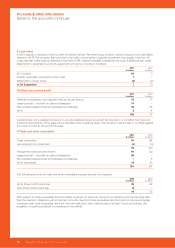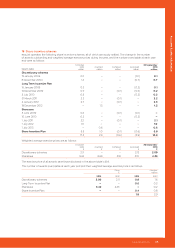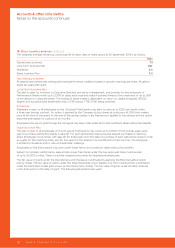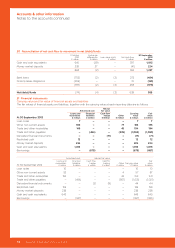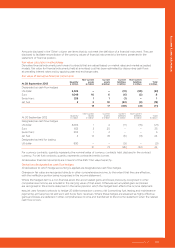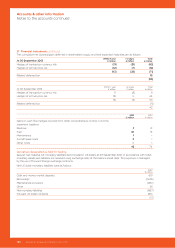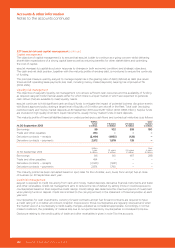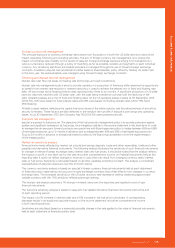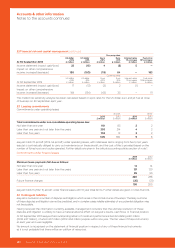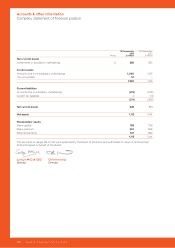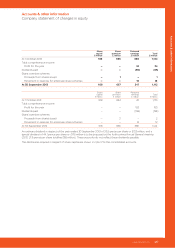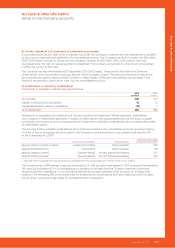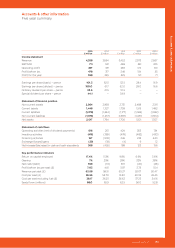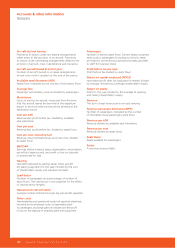EasyJet 2013 Annual Report Download - page 124
Download and view the complete annual report
Please find page 124 of the 2013 EasyJet annual report below. You can navigate through the pages in the report by either clicking on the pages listed below, or by using the keyword search tool below to find specific information within the annual report.
easyJet plc Annual report and accounts 2013
$FFRXQWVRWKHULQIRUPDWLRQ
Notes to the accounts continued
)LQDQFLDOULVNDQGFDSLWDOPDQDJHPHQWcontinued
"@OHS@KL@M@FDLDMS
The objective of capital management is to ensure that easyJet is able to continue as a going concern whilst delivering
shareholder expectations of a strong capital base as well as returning benefits for other stakeholders and optimising
the cost of capital.
easyJet manages its capital structure in response to changes in both economic conditions and strategic objectives.
The cash and net debt position, together with the maturity profile of existing debt, is monitored to ensure the continuity
of funding.
The principal measure used by easyJet to manage capital risk is the gearing ratio of debt (defined as debt plus seven
times aircraft operating lease payments less cash, including money market deposits). Gearing has improved at 7%
(2012: 29%).
+HPTHCHSXQHRJL@M@FDLDMS
The objective of easyJet’s liquidity risk management is to ensure sufficient cash resources and the availability of funding
as required. easyJet holds financial assets either for which there is a liquid market or which are expected to generate
cash inflows that are available to meet liquidity needs.
easyJet continues to hold significant cash and liquid funds to mitigate the impact of potential business disruption events
with Board approved policy stating a target level of liquidity of £4 million per aircraft in the fleet. Total cash (excluding
restricted cash) and money market deposits at 30 September 2013 was £1,237 million (2012: £883 million). Surplus funds
are invested in high quality short-term liquid instruments, usually money market funds or bank deposits.
The maturity profile of financial liabilities based on undiscounted gross cash flows and contractual maturities is as follows:
$W6HSWHPEHU
:LWKLQ
\HDU
PLOOLRQ
\HDUV
PLOOLRQ
\HDUV
PLOOLRQ
2YHU
\HDUV
PLOOLRQ
Borrowings
Trade and other payables ± ± ±
Derivative contracts – receipts ±
Derivative contracts – payments ±
At 30 September 2012
Within
1 year
£ million
1-2 years
£ million
2-5 years
£ million
Over
5 years
£ million
Borrowings 146 140 467 288
Trade and other payables 454 – – –
Derivative contracts – receipts (2,943) (1,821) – –
Derivative contracts – payments 2,874 1,790 – –
The maturity profile has been calculated based on spot rates for the US dollar, euro, Swiss franc and jet fuel at close
of business on 30 September each year.
"QDCHSQHRJL@M@FDLDMS
easyJet is exposed to credit risk arising from cash and money market deposits, derivative financial instruments and trade
and other receivables. Credit risk management aims to reduce the risk of default by setting limits on credit exposure to
counterparties based on their respective credit ratings. Credit ratings also determine the maximum period of investment
when placing funds on deposit. Credit risk is limited to the carrying amount in the statement of financial position at each
year end.
Counterparties for cash investments, currency forward contracts and jet fuel forward contracts are required to have
a credit rating of A or better at contract inception. Exposures to those counterparties are regularly reviewed and, when
the market view of a counterparty’s credit quality changes, adjusted as considered appropriate. Accordingly in normal
market conditions, the probability of material loss due to non-performance by counterparties is considered to be low.
Disclosure relating to the credit quality of trade and other receivables is given in note 11 to the accounts.
122 easyJet plc Annual report and accounts 2013


